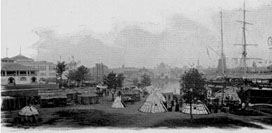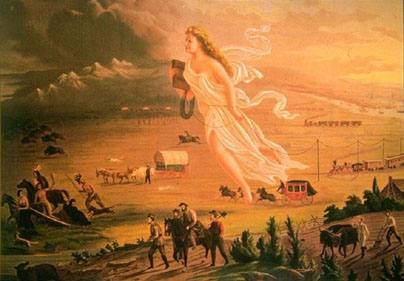|

American Indians at Chicago's Columbian Exposition |
The idea of Manifest Destiny, as portrayed in John Gast’s 1872 painting "American Progress," became the dominant theme in American History during the late-19th century (and reached its apex at roughly the same time as the Columbian Exposition).
A short description: IN JOHN GAST'S "AMERICAN PROGRESS," (1872) A DIAPHANOUSLY ANDPRECARIOUS CLAD AMERICA FLOATS WESTWARD THRU THE AIR WITH THE "STAR OF EMPIRE" ON HER FOREHEAD. SHE HAS LEFT THE CITIES OF THE EAST BEHIND, AND THE WIDE MISSISSIPPI, AND STILL HER COURSE IS WESTWARD. IN HER RIGHT HAND SHE CARRIES A SCHOOL BOOK--TESTIMONIAL OF THE NATIONAL ENLIGHTENMENT, WHILE WITH HER LEFT SHE TRAILS THE SLENDER WIRES OF THE TELEGRAPH THAT WILL BIND THE NATION. FLEEING HER APPROACH ARE INDIANS, BUFFALO, WILD HORSES, BEARS, AND OTHER GAME, DISAPPEARING INTO THE STORM AND WAVES OF THE PACIFIC COAST. THEY FLEE THE WONDEROUS VISION--THE STAR "IS TOO MUCH FOR THEM." --A CONTEMPORARY DESCRIPTION
OF THIS PAINTING BY GEORGE CROFUTT WHO DISTRIBUTRED HIS ENGRAVING
OF IT WIDELY.
When you look at Gast's painting, consider these questions?
|
| |
Department
of Anthropology |
copyright © 2002
University of Illinois, All rights reserved. |


